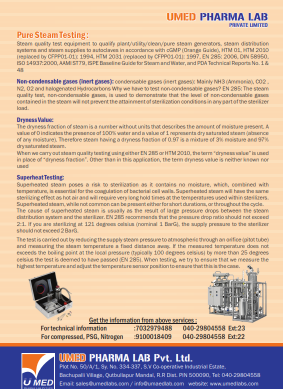
Steam quality test equipment to qualify plant/utility/clean/pure steam generators, steam distribution systems and steam supplies to autoclaves in accordance with cGMP (Orange Guide), HTM 01, HTM 2010 (replaced by CFPP01-0l): 1994, HTM 2031 (replaced by CFPP01-0l): 1997, EN 285: 2006, DIN 58950, ISO14937:2000, AAMIST79, ISPEBaselineGuideforSteam and Water, and PDATechnical Reports No.l&48
Non-condensable gases (inert gases): condensable gases (inert gases): Mainly NH3 (Ammonia), C02, N2, 02 and halogenated Hydrocarbons Why we have to test non-condensable gases? EN 285: The steam quality test, noncondensable gases, is used to demonstrate that the level of non-condensable gases contained in the steam will not prevent the attainment of sterilization conditions in any part of the sterilizer load.
Dryness Value: The dryness fraction of steam is a number without units that describes the amount of moisture present. A value of 0 indicates the presence of 100% water and a value of 1 represents dry saturated steam (absence of any moisture). Therefore steam having a dryness fraction of 0.97 is a mixture of 3% moisture and 97% dry saturated steam.
When we carry out steam quality testing using either EN 285 or HTM2010, the term "dryness value" is used in place of "dryness fraction". Other than in this application, the term dryness value is neither known nor used
Superheat Testing: Superheated steam poses a risk to sterilization as it contains no moisture, which, combined with temperature, is essential for the coagulation of bacterial cell walls. Superheated steam will have the same sterilizing effect as hot air and will require very long hold times at the temperatures used within sterilizers. Superheated steam, while not common can be present either for short durations or throughout the cycle. The cause of superheated steam is usually as the result of large pressure drops between the steam distribution system and the sterilizer. EN 285 recommends that the pressure drop ratio should not exceed 2:1. If you are sterilizing at 121 degrees Celsius (nominal 1 Barg), the supply pressure to the sterilizer should not exceed 2 BarG.
The test is carried out by reducing the supply steam pressure to atmospheric through an orifice (pitot tube) and measuring the steam temperature a fixed distance away. If the measured temperature does not exceed the boiling point at the local pressure (typically 100 degrees Celsius) by more than 25 degrees Celsius the test is deemed to have passed (EN 285). When testing, we try to ensure that we measure the highest temperature and adjust the temperature sensor position to ensure that this is the case.